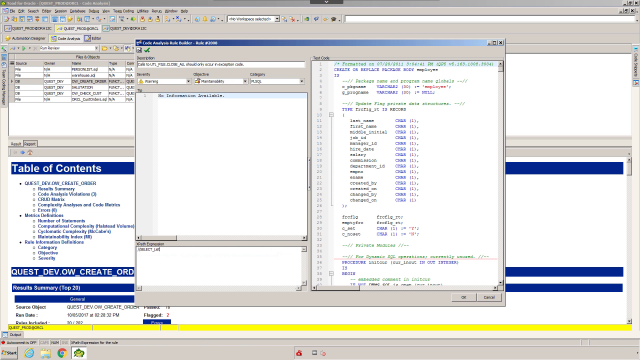How to work with Code Analysis rules in Toad for Oracle
 06:34
06:34
Related videos
How to Use Generative AI Features in Toad for Oracle
In this short video you will learn how to use generative AI features in Toad for Oracle.
03:53
Work smarter, not harder with Toad for Oracle
Discover why Toad for Oracle remains the top choice for database professionals seeking smarter, more efficient ways to manage their Oracle environments. From au...
01:24
Toad for Oracle: What's New with Toad?
In this Toad for Oracle product demo we'll review the most recent updates of each of the Toad Editions.
22:21
Venkat Rajaji offers observations on Quest's market leadership
Learn how Quest maintains the lead in database management tools, as well as the emerging trends in compliance issues, autonomous databases and cloud migration.
08:56
Toad for Oracle product overview
Learn how you can reduce the time and effort required to develop, manage and maintain Oracle databases.
01:07
Setting up Team Coding with VCS integration
When working with code and other schema objects, it’s important to use a version control system to track changes, especially if you’re thinking of integrating d...
09:36
Quest Highlights from Oracle OpenWorld 2018
2018 marked the most exciting Oracle OpenWorld yet. Relive the fun and revisit the booth staff in this highlight reel.
01:31
Optimize SQL and PL/SQL using Optimize Current SQL
Developers often struggle with SQL tuning, often calling upon a DBA to help. In the world of agile processes and Continuous Integration, this approach no longer...
06:56
Using the Quest® Toad® for Oracle Benefits Calculator
Get a quick demonstration of our interactive benefits calculator for Quest® Toad® for Oracle. By entering variables and assumptions about your DBAs and develop...
09:51
Managing document interfaces in Toad for Oracle
In this video, see how to take the most advantage of the monitor space you have when using Toad for Oracle.
03:07
Learn about the benefits provided by Toad for Oracle Xpert Edition
Learn about the benefits provided by Toad for Oracle Xpert Edition.
05:39
Introduction to Toad for Oracle for Developers - in-depth tutorial
Introduction to Toad for Oracle for Developers - in-depth tutorial
26:05
Introduction to Toad for Oracle for DBAs - in-depth tutorial
Introduction to Toad for Oracle for DBAs - in-depth tutorial
32:26
Insights into DBA challenges and update on Toad from Julie Hyman
In this interview, learn about the latest changes in Toad and common concerns from DBAs when adopting DevOps culture.
03:51
